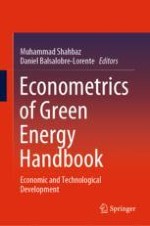2020 | OriginalPaper | Chapter
4. Optimal Forecast Models for Clean Energy Stock Returns
Authors : Victor Troster, Muhammad Shahbaz, Demian Nicolás Macedo
Published in: Econometrics of Green Energy Handbook
Publisher: Springer International Publishing
Activate our intelligent search to find suitable subject content or patents.
Select sections of text to find matching patents with Artificial Intelligence. powered by
Select sections of text to find additional relevant content using AI-assisted search. powered by
